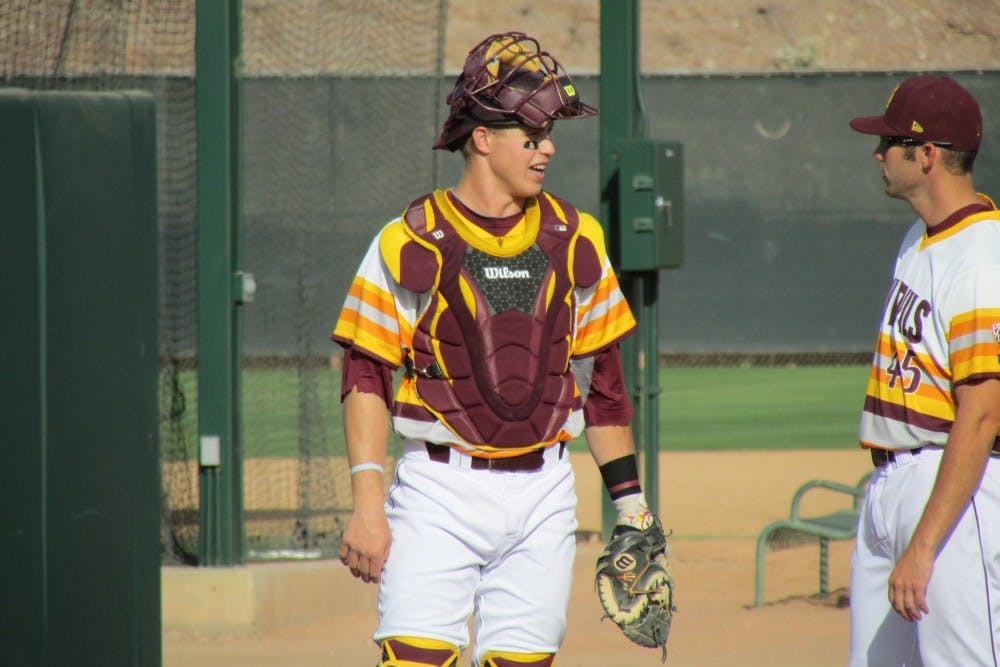Don’t ask Brian Serven about how many base runners he’s thrown out — he’s not sitting at home crossing the names of his caught-stealing victims off a list.
But he will acknowledge how good he’s become at it.
“He’s a weapon back there,” ASU baseball head coach Tracy Smith said. “He’s improved, and he’s really worked on it.”
Last season in 55 games as a freshman catcher (he started all but five of them), Serven picked off 15 of 36 base runners.
He’s already matched that total as a sophomore through 33 games, about two-thirds of the way through the 2015 season: 40 have tried, and 15 have failed to steal a base with Serven behind the plate.
“Keeping a guy off second base is huge for a defense,” Serven said. “Anytime you have a runner in scoring position, a hit can score them, so it’s always nice to get guys off second and third.”
Of course, any successful stolen base or pickoff is (at minimum) a three-step process.
Smith watches intently from the dugout, looking to see if baserunner conveys any body language that might tip off his intentions.
Is he leaning toward second? Does he react to a sign from his third base coach?
“I get a feeling sometimes,” Serven said. “(Smith) has been around the game so long that he has a sense of when guys are edgy, if they’re going to run or not. I think it’s just a feeling he gets, and he guesses right (most) of the time."
Of course, the other keys to breaking down an ideal stolen base situation: Are there less than two outs, and does the count favor the hitter?
Then, he gives Serven his sign. If it’s a pitchout, then it’s on the catcher to communicate this to the pitcher and middle infielders Colby Woodmansee and Andrew Snow (depending on which side of the plate the hitter swings from) to ensure that ASU isn’t showing the opposing team its hand in this mental poker game.
“(Smith) really knows, when he thinks a guy is going to run or not,” Serven said. “There’s been a number of times when we’ve had a pitchout or had the pitcher slide step and throw a fastball outside because he thought a guy was running, and he was.”
There are multiple factors involved in a successful pitchout call, some of which is the result of good luck and even better timing.
As Smith and Serven both recognized, the quicker the delivery of a pitcher from the mound to home plate, the better.
A proverbial game of inches, there are fewer close plays in baseball than when a runner tries to steal second base.
It’s a longer throw, giving a runner a slight advantage, even if the ball will travel faster than the runner does no matter how fast he is.
In about 3-4 seconds, the ball leaves the pitcher’s hand, lands in Serven’s glove 60 feet away – (More than that, because he’s stationed behind home plate) and Serven explodes out of his crouch and fires a strike to second base, 127 feet, 3 and 3/8 inches in front of him.
“We work on getting the footwork down first,” Serven said. “ It’s huge, because the pitchers really control the game, and they’re the ones who help that out.”
Being a catcher is often an unsung role, as the often-referenced “tools of ignorance” have lived on in baseball lore even though the protective equipment has improved.
Diving in the dirt, immediately dropping from a squatted stance to on both knees to put any part of one’s body in front of the ball to prevent giving a free base — it’s tempting to runners, but those who have taken the bait have lived to regret it.
“Where I think he’s even more lethal is how well he blocks the ball and then pounces on it and makes the throw,” Smith said.
With very little time to react between Seth Martinez sliders, Ryan Burr fastballs, and Ryan Kellogg curveballs, even blinking while a pitcher begins their motion is probably a bad idea.
“It’s also (because) the pitchers are doing a better job of being quicker to the plate,” Smith said. “It’s a combination of everything.”
Even though left-handed pitchers tend to have quicker pickoff moves, Serven’s caught five of nine runners trying to run on the right-handed Martinez.
With lefty Brett Lilek on the mound, he’s seen the most action, nailing four of 14 base-stealers.
There aren’t gold star stickers handed out for being a good catcher, and throwing runners out is a key part of the job description.
But with the success the Sun Devils have enjoyed in close games, every run counts.
So far, Serven’s been directly responsible for saving 15 of them.
“In a game, it just becomes instinct,” Serven said. “As long as I get the ball down to second, then the guy will most likely be out.”
Reach the reporter at smodrich@asu.edu or follow @StefanJModrich on Twitter.
Like State Press Sports on Facebook and follow @statepressport on Twitter.




